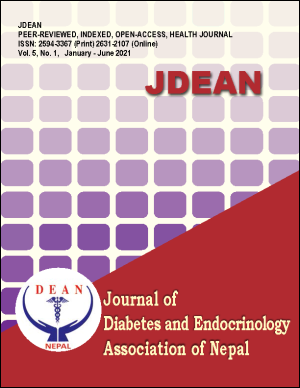Adequacy of Thyroid Homone Replacement in a Tertiary Care Hospital in Nepal-An Observational Study
DOI:
https://doi.org/10.3126/jdean.v5i1.38802Keywords:
Primary Hypothyroidism, Treatment Outcome, LevothyroxinAbstract
Background: The therapeutic goal in hypothyroidism is to achieve patients’ well-being and restore serum thyrotropin (TSH) to levels within the reference range. However, inadequate or over replacement is common in patients receiving levothyroxine. The Objective is to assess the treatment outcome of hypothyroid patients visiting outpatient clinic of medicine department of Kathmandu University Hospital, Dhulikhel, Nepal.
Method: This is a cross sectional study on diagnosed Primary Hypothyroid patients who were taking levothyroxine replacement for at least six months. Patients were defined as euthyoid if their TSH was in the normal range (0.3-3.6 mmol/L) according to the hospital laboratory. Similarly patients were defined as over treated if TSH is <0.3 mmol/L and undertreated if TSH is >3.6 mmol/L.
Results: A total number of 126 patients were enrolled for this study where mean age of participants was 40.88 ± 11.47 years and only 15 (11.1%) were male. Mean duration of hypothyroidism was 3.45 ± 2.57 years and mean Levothyroxine dose was 58.93 ± 26.89 mcg. In this study, nearly 70% of participants have normal TSH level. Similarly, 21% of participants have higher level of TSH and 9% have low TSH level. Multivariate logistic regression analysis did not show any significant co relation between treatment outcome and various variables.
Conclusion: Treatment of hypothyroidism with levothyroxine being most effective, easily available, simple regimen and not costly, still one third of patients are not meeting the treatment outcome. However, being the pioneer study from Nepal, this study suggests improved treatment outcomes compared to similar studies from other countries.
Downloads
Downloads
Published
How to Cite
Issue
Section
License
Copyright (c) 2021 H.K. Shrestha, R. Tamrakar, A. Shrestha, M. Uprety, B. Shrestha

This work is licensed under a Creative Commons Attribution-NonCommercial 4.0 International License.
This license enables reusers to distribute, remix, adapt, and build upon the material in any medium or format for non-commercial purposes only, and only so long as attribution is given to the creator.




